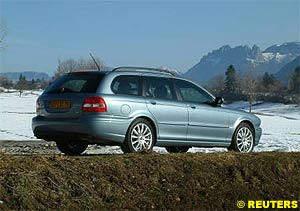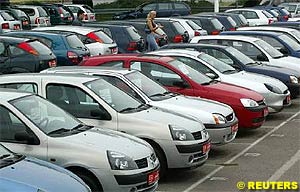

Automotive News and Reviews for the Petrolhead
Reuters Motoring Commentator
In this week's issue:
- Road Test: Jaguar's First Estate in 82 years
- New Models Coax Motorists into Showrooms
The Jaguar has long been the automotive equivalent of a trilby. Old fashioned, predictable, quintessentially British - and much loved by the old guard and bookies.
Against prestige rivals from Mercedes, BMW, Audi and the like, Jaguars have looked quaint at best. To most eyes they have bordered on the preposterous.
Jaguar eventually cottoned on to the fact that the world had moved on from overweight saloons and cumbersome grand-tourers. But it didn't make much of a difference. The S-type saloon looked out of date from the moment it was launched in 1999. It was only when the 'baby Jag' X-type joined the line-up in 2001 that the brand started to attract serious attention.
But still it lagged behind. By that time, executive car buyers had recognised that modern-generation diesels made more sense than big, thirsty petrol powerplants. And growing numbers - particularly of younger buyers - were opting for more practical 'lifestyle' estate cars.
The product planners within Ford's Premier Automotive Group (which also includes Land Rover, Aston Martin and Volvo) could see the petrol-powered Jaguar X-type saloons were only appealing to around a quarter of buyers in the sector. So last year they introduced a diesel option and now - 82 years after the birth of the Coventry-based firm - they have finally brought us a Jaguar estate.
Worth The Wait?
The diesel was an immediate hit. It already accounts for around two-thirds of X-type sales, taking Jaguar sales last month to their highest level ever. The new estate will increase Jaguar sales still further.
The new model is not exactly groundbreaking. Its luggage capacity compares reasonably well with more familiar class leaders such as the BMW 3-series Touring and Audi A4 Avant. But other than removable interior side panels behind the rear wheel arches which give extra width for especially wide loads, it offers nothing new.
However, the addition of the estate section has been very well handled by the Jaguar design team. The bodywork is completely new from the B-pillars to the rear bumper and is better proportioned than the saloon. The only element that jars is the over-sized rear lights, which intrude clumsily into the lines of the rear hatch.
Other details are well executed. The rear seats are split 60/40 and fold flat, as well as offering a central hatch for carrying skis. The window in the rear hatch also opens separately for easier access to the load area, and roof rails in matt black or chrome are fitted as standard.
Living the Lifestyle
The interior of the X-type is equally good, but not class leading. Attractive? Yes. Comfortable? Yes. Sophisticated? Reasonably. But some details annoy. The switches are scattered around the dashboard, steering wheel and central console. The instrumentation is plain and slightly downmarket and there are bulky intrusions into the front footwells. While the belated addition of an estate and a diesel engine bring Jaguar back into the game, the X-type still feels somewhat outdated.
For outright power, the V6 petrol engines are attractive. The 2.0-litre unit offers 155bhp, the 2.5 boasts 191bhp and the silken 3.0 gives a mighty 228bhp. The bigger two units are also matched with four-wheel drive transmissions for extra grip.
But in the real world of car ownership, they are hard to justify. The 2.0-litre turbodiesel has got 100bhp less than the top model and puts the power to the road through the front wheels only. But the difference is not worth £6,605.
It is same powerplant as fitted to the Ford Mondeo, but Jaguar's engineers have worked wonders to eradicate the poor cousin's rattles. With a mighty 244lb ft of torque at just 1800rpm, the diesel engine provides excellent pulling power and impressive in-gear acceleration. It is only on long, fast straights that the 3.0-litre petrol version can pull away.
On paper, the performance statistics look unimpressive. Even a Mini Cooper is quicker from 0-60 and achieves a higher top speed. But on the road, the X-type diesel estate never feels underpowered. The rear suspension has been stiffened to cope with the extra 65kg weight and the newcomer feels fast, well-poised and sporty.
Its appeal grows stronger still when one studies the figures relating to cost. Not only does it travel almost 50 miles on every gallon of diesel. It is also in a lower insurance group than the class-leading Audi Avant, its CO2 rating of 154g/km is competitive and the engine is Euro4 compliant, which means it is exempt from the 3% company car tax surcharge. The X-type diesels have lower depreciation than their petrol counterparts too, so the total cost per mile is far lower.
A few years ago, it was hard to make a rational argument for a Jaguar. They were big, petrol-powered saloons that you chose with your heart, rather than your head. How things change! With the addition of a diesel engine and now a stylish estate, Ford has thrown away the trilby and kicked Jaguar back into contention. The new X-type diesel estate is not a class leader, but it offers a distinctive, stylish and rational alternative to the prestige German marques that have dominated the sector for so long.
Written by David Sumner Smith
Car sales in western Europe rose for a second straight month in March as new models coaxed motorists back into showrooms and nurtured a nascent industry recovery, data show.
But with much of the 6.9 percent rise driven by extra business days over the Easter holiday period, analysts argued it was still too early to herald a fully-fledged revival.
"The headline figure might seem good but the market is not really flourishing," said one autos analyst at Deutsche Bank. "When you account for the extra business days, sales were pretty flat and we are not counting on much growth this year."
Most manufacturers have predicted growth of one to two percent in 2004, compared with a dip of around 1.3 percent last year, when the war in Iraq and wider economic gloom eroded consumer confidence, particularly in France and Germany.
And despite some signs previously thrifty motorists are starting to return to showrooms, many experts still do not predict a sharp upturn until the second half of the year.
"It's when rather than if," said Robert Ashton, analyst at Commerzbank. "But we haven't seen a recovery yet in the French and German markets, which is a bit disappointing."
Sales in France and Germany -- the euro zone's top two economies -- are down about 2.7 percent so far this year.
Japanese Inroads
The auto industry accounts for about four percent of the European Union's gross domestic product and reflects the wider economy, in particular consumer confidence. Japanese carmakers, with the exception of Nissan, continued to increase their share of the ultra-competitive market at the expense of their European rivals to 14 percent from 13.2 percent last year.
The world's second biggest carmaker Toyota saw sales rise 20 percent while smaller rival Mazda, the region's fastest growing brand, boosted sales by almost 40 percent thanks to new niche models.
All major European carmakers boosted sales except PSA Peugeot Citroen, which is struggling with an ageing model line-up, a weak home market and tough competition from rival Volkswagen. PSA sales fell 2.1 percent.
Europe's biggest carmaker Volkswagen lifted sales 11.6 percent, in part thanks to profit-eroding incentives like free air conditioning on its top-selling Golf model. Germany's BMW also fared well, powering sales 14 percent higher.
France's Renault increased sales by just four percent, losing market share as it pulled out of less profitable business, like short-term leasing, to focus on margins.
Written by Rebecca Harrison
![]() Road Test: Jaguar's First Estate in 82 years
Road Test: Jaguar's First Estate in 82 years
 The figures speak for themselves: In the X-type's junior executive class, petrol and diesel powered saloons each take a 28% share of sales. Estates account for a 34% share, with diesels outselling petrol powered models 3 to 2. Only amongst the coupe and convertible sub-set, which accounts for 10% or the segment, do petrol models outsell diesels.
The figures speak for themselves: In the X-type's junior executive class, petrol and diesel powered saloons each take a 28% share of sales. Estates account for a 34% share, with diesels outselling petrol powered models 3 to 2. Only amongst the coupe and convertible sub-set, which accounts for 10% or the segment, do petrol models outsell diesels.
![]() New Models Coax Motorists into Showrooms
New Models Coax Motorists into Showrooms
 Brussels-based carmakers association ACEA said in a statement on last week new car registrations rose to 1.707 million cars in March from 1.597 million in the year-ago period. That meant total vehicle sales in the first quarter were up 2.9 percent compared with a year ago.
Brussels-based carmakers association ACEA said in a statement on last week new car registrations rose to 1.707 million cars in March from 1.597 million in the year-ago period. That meant total vehicle sales in the first quarter were up 2.9 percent compared with a year ago.
| Contact the Editor |
© 1995-2005 Kaizar.Com, Inc. . This service is provided under the Atlas F1 terms and conditions.
|
Volume 10, Issue 16
Atlas F1 Exclusive
Interview with Bob Bell
Interview with Gianmaria Bruni
Articles
Every Other Sunday
The Paint Job: Part V
2004 San Marino GP Preview
2004 San Marino GP Preview
San Marino GP Facts & Stats
Columns
The F1 Trivia Quiz
Rear View Mirror
Bookworm Critique
On the Road
Elsewhere in Racing
The Weekly Grapevine
> Homepage |